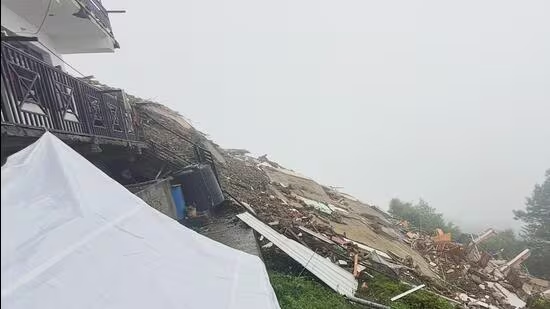A five-storey building collapsed in Shimla on Saturday, sparking fresh concerns over construction safety in the ecologically sensitive region. While the incident did not result in any casualties, it has raised serious questions about building regulation and urban planning in the hill city. Officials confirmed that the structure had been declared unsafe earlier and was unoccupied at the time of collapse.
Location and Official Confirmation
According to The Times of India, the incident occurred in the Krishna Nagar locality, one of Shimla’s older and densely built-up areas. According to local authorities, the five-storey structure had developed visible cracks following heavy rains earlier this week. The Shimla Municipal Corporation, acting on precautionary advice, had evacuated all occupants in time.
“No casualties have been reported. The building was already vacated after being declared unsafe,” said a senior municipal official, adding that adjoining buildings are now being inspected for any signs of structural weakness.
Emergency Response and Safety Measures
The moment the collapse was reported, local police, fire services, and disaster response personnel rushed to the site. The area was cordoned off to ensure public safety, and clearance of debris was initiated. Authorities also inspected neighboring buildings, especially those sharing a foundation or adjacent slope with the collapsed structure.
Officials are now working to conduct a rapid structural audit of all multi-storey buildings in Shimla that were built prior to modern construction codes or in areas classified as landslide-prone. Residents in adjoining buildings have been temporarily moved out while the risk is assessed.
Rainfall and Structural Vulnerability
The building collapse in Shimla has once again brought attention to the vulnerability of hill town infrastructure, particularly during the monsoon season. Over the past week, Shimla and surrounding areas have received continuous rainfall, leading to waterlogging, soil erosion, and minor landslides. These environmental pressures weaken the foundations of older buildings, many of which were not designed with such climatic stress in mind.
Experts have long warned about the consequences of unregulated construction in Himalayan towns. The combination of steep slopes, unpredictable weather, and poor drainage systems makes these regions extremely fragile. Without rigorous enforcement of building codes, such disasters are likely to recur.
Urban Planning Challenges in Hill Stations
Shimla’s growth over the decades has been marked by a lack of coordinated urban planning. A boom in real estate and tourism-related construction has led to a mushrooming of buildings in landslide-prone areas. In many cases, construction has taken place without adequate geological surveys or adherence to safety standards.
Officials from the Town and Country Planning Department admitted that many structures in the city are old and were built before the current building norms were enforced. They emphasized that a long-term solution would require extensive retrofitting and stricter oversight of new construction.
Environmental activists have reiterated the need for a comprehensive hill development policy that prioritizes sustainable growth. They argue that the current development model is unsustainable and puts lives and the natural ecosystem at risk.
Political and Public Response
The state government has ordered a preliminary inquiry into the circumstances surrounding the collapse. Chief Minister Sukhvinder Singh Sukhu has instructed the administration to submit a detailed report and ensure that any negligence in inspection or follow-up action is identified.
Opposition parties have criticized the ruling government for failing to enforce existing safety regulations and for ignoring the long-standing concerns of urban geologists and engineers about over-construction in sensitive zones.
Public sentiment, especially among residents of older neighborhoods, is one of concern and urgency. Several citizens have appealed for immediate audits of their buildings and have demanded greater transparency in how building safety evaluations are conducted.
The Way Ahead
Though no casualties were reported in the Shimla five-storey building collapse, the incident should not be seen as an isolated mishap. Instead, it should serve as a warning and a call to action for local authorities, urban planners, and residents. As the monsoon progresses and weather patterns continue to intensify, the risk of similar incidents remains high.
The state must prioritize a policy shift toward preventive infrastructure assessment, enforce stricter penalties for code violations, and empower civic bodies with the resources needed for real-time monitoring of structural risks.
Follow us for latest updates:




